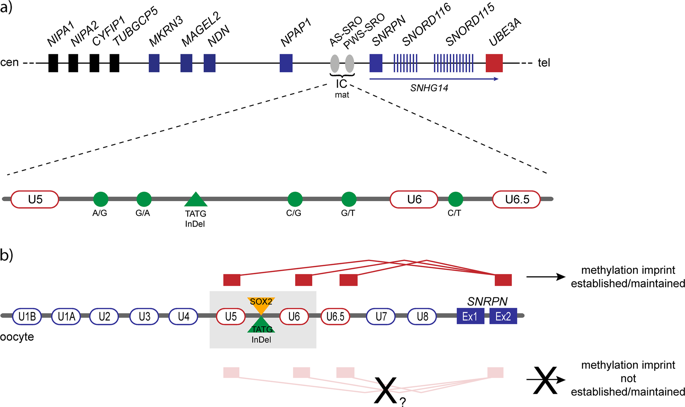European Journal of Human Genetics ( IF 3.7 ) Pub Date : 2020-03-09 , DOI: 10.1038/s41431-020-0595-y Jasmin Beygo 1 , Christian Grosser 1, 2 , Sabine Kaya 1 , Claudia Mertel 1 , Karin Buiting 1 , Bernhard Horsthemke 1

|
Angelman syndrome (AS) is a rare neurogenetic imprinting disorder caused by the loss of function of UBE3A. In ~3–5% of AS patients, the disease is due to an imprinting defect (ID). These patients lack DNA methylation of the maternal SNRPN promotor so that a large SNRPN sense/UBE3A antisense transcript (SNHG14) is expressed, which silences UBE3A. In very rare cases, the ID is caused by a deletion of the AS imprinting centre (AS-IC). To search for sequence alterations, we sequenced this region in 168 patients without an AS-IC deletion, but did not detect any sequence alteration. However, the AS-IC harbours six common variants (five single nucleotide variants and one TATG insertion/deletion variant), which constitute five common haplotypes. To determine if any of these haplotypes is associated with an increased risk for an ID, we investigated 119 informative AS-ID trios with the transmission disequilibrium test, which is a family-based association test that measures the over-transmission of an allele or haplotype from heterozygous parents to affected offspring. By this we observed maternal over-transmission of haplotype H-AS3 (p = 0.0073). Interestingly, H-AS3 is the only haplotype that includes the TATG deletion allele. We conclude that this haplotype and possibly the TATG deletion, which removes a SOX2 binding site, increases the risk for a maternal ID and AS. Our data strengthen the notion that the AS-IC is important for establishing and/or maintaining DNA methylation at the SNRPN promotor and show that common genetic variation can affect genomic imprinting.
中文翻译:

Angelman综合征印记中心的常见遗传变异会影响15号染色体的印记。
Angelman综合征(AS)是由UBE3A功能丧失引起的一种罕见的神经遗传印记障碍。在约3–5%的AS患者中,该疾病归因于印记缺陷(ID)。这些患者缺乏母体的DNA甲基化SNRPN启动子,使得大SNRPN感/ UBE3A反义转录物(SNHG14)被表示,其中沉默UBE3A。在极少数情况下,ID是由删除AS刻印中心(AS-IC)引起的。为了搜索序列改变,我们在168位没有AS-IC缺失的患者中对该区域进行了测序,但未检测到任何序列改变。但是,AS-IC具有六个常见的变异体(五个单核苷酸变异体和一个TATG插入/缺失变异体),它们构成了五个常见的单倍型。为了确定这些单倍型是否与ID风险增加相关,我们使用传播不平衡测试调查了119个信息丰富的AS-ID三重奏,这是一种基于家庭的关联测试,用于测量等位基因或单倍型的过度传播从杂合的父母到受影响的后代。由此我们观察到母体单倍型H-AS3(p = 0.0073)。有趣的是,H-AS3是唯一包含TATG缺失等位基因的单倍型。我们得出的结论是,这种单倍型以及可能的TATG缺失会删除SOX2结合位点,增加了产妇ID和AS的风险。我们的数据强化了AS-IC对于在SNRPN启动子上建立和/或维持DNA甲基化非常重要的观念,并表明常见的遗传变异会影响基因组印迹。











































 京公网安备 11010802027423号
京公网安备 11010802027423号